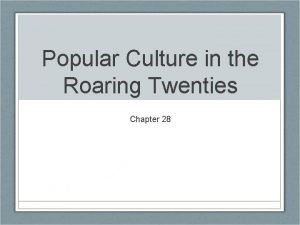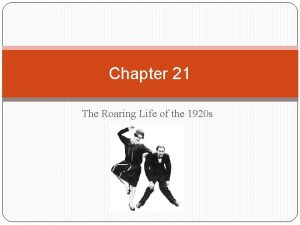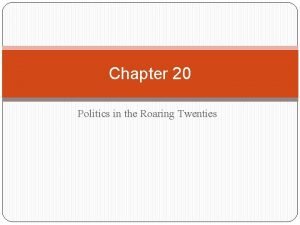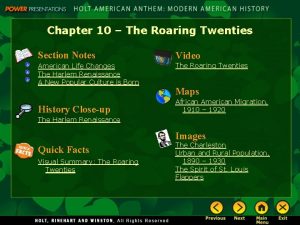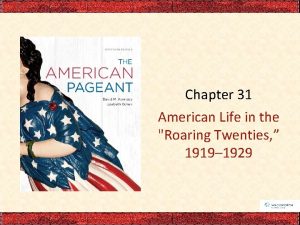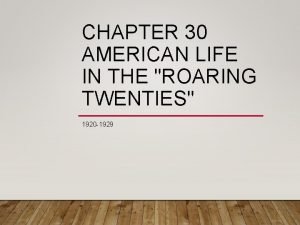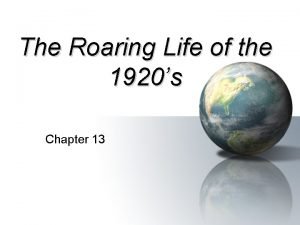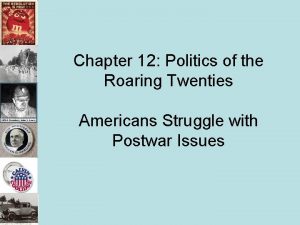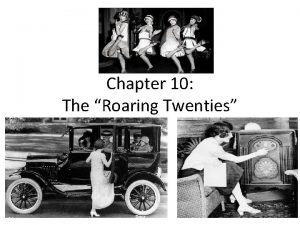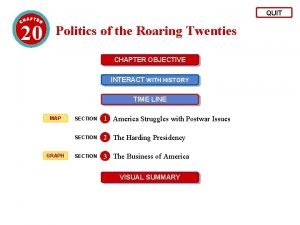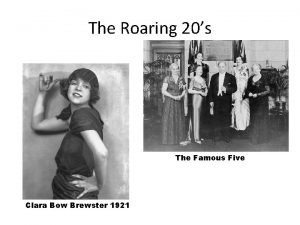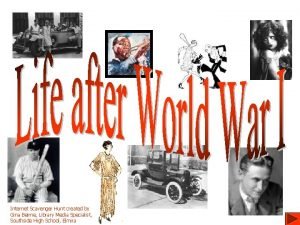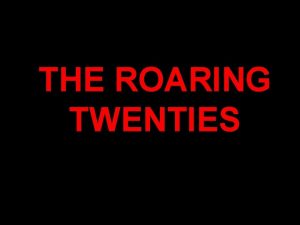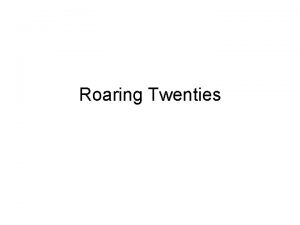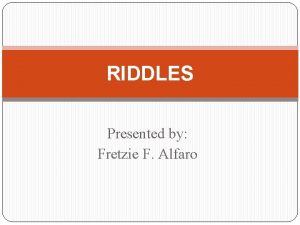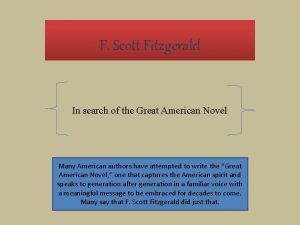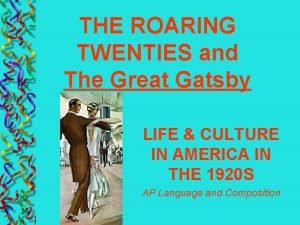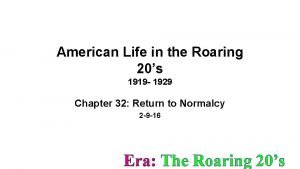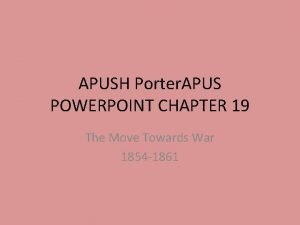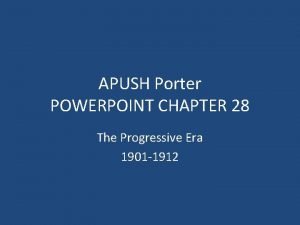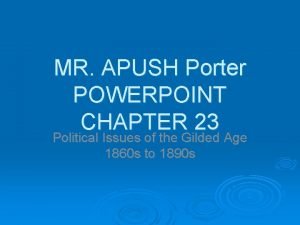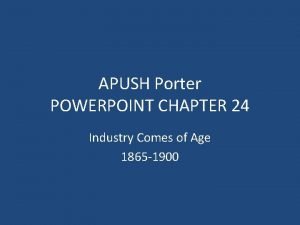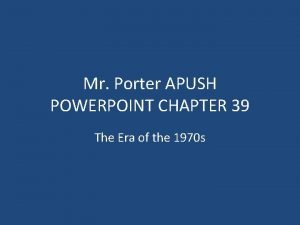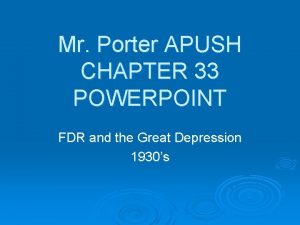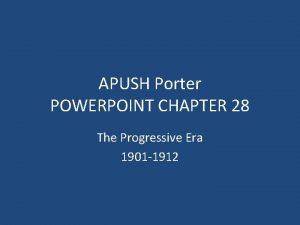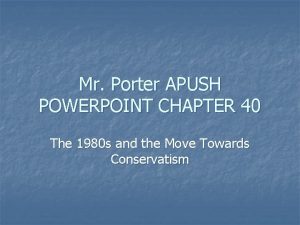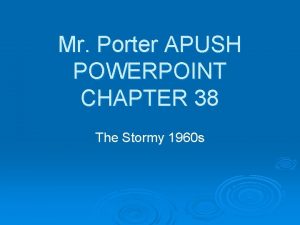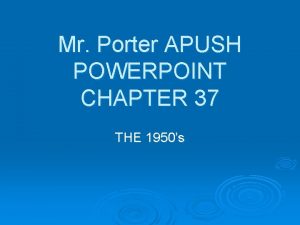Mr Porter APUSH POWERPOINT CHAPTER 31 THE ROARING


































- Slides: 34

Mr. Porter APUSH POWERPOINT CHAPTER 31 THE ROARING TWENTIES DOMESTIC CHANGES

KEYS TO THE CHAPTER • • • The “Red Scare” Fear of Immigrants Alcohol is Banned Consumer Consumption Economy Tax Policy is changed Assembly Line Production Mass Transportation Entertainment for the masses Increased Urbanization / Economic Speculation

Economic Expansion, 1920– 29 -----A period of Prosperity

• 1919 – 1920 – “Red Scare” in US – 1917 – Bolsheviks took power in Russia – June 1919 – bomb at A. G. Palmer’s home – September 1920 – bomb on Wall St. kills 38 – December 1919 – 249 alien radicals deported – States outlaw advocacy of violence for social change – Palmer arrests 5 K on weak evidence w/o warrants

America fears the change sweeping Europe

• Businessmen used fear of socialism to drive out attempts to unionize • Fear of Anarchists/Socialists spreads – Sacco (shoe-factory worker) and Vanzetti (fish peddler) – 1921 – convicted of murdering a Massachusetts shoe factory paymaster and his guard in 1920 robbery of 15 K • They were Italian, atheists, anarchists, & draft dodgers – August 23, 1927 – both electrocuted

Nicola Sacco & Bartolomeo Vanzetti

• Ku Klux Klan rises in popularity across the nation – Against forces of diversity and modernity of 1920 s – Anti-foreign, anti. Catholic, anti-black, anti -Jewish, anti-pacifist, anti-Communist, antiinternationalist, antievolutionist, , anti-birth control – Pro-Anglo-Saxon, pro“native” American, pro. Protestant

• Immigration began again but most from Southern and Eastern Europe • Emergency Quota Act of 1921 – Temporary measure – Quota of 3% of nationality of those in US in 1910 • Many southern / eastern Europeans were in US by 1910 • Immigration Act of 1924 /Changes America forever – Quotas cut from 3% to 2% and base shifted from 1910 to 1890 to limit S/E immigration • Belief that northern European were superior race – Japanese immigration completely stopped • “Hate America” rallies held in Japan – Canadians and Latin Americans exempted • Brought in for jobs; sent home when jobs scarce

• 1919 – Eighteenth Amendment passed – Volstead Act (1919) – Congress passed to enforce Prohibition – South and West Support but the East opposes it

• Why prohibition failed – Tradition of alcohol in America – Tradition of weak control by central government – Difficult to enforce law which majority opposed – Soldiers argued law passed while they were in Europe – Understaffed and underpaid federal enforcers • Successes of Prohibition – Bank savings increased – Absenteeism in work decreased – Less alcohol consumed overall

Customers Enjoying a Drink at a Speakeasy ------Note fancy clothes but poor surroundings

• Huge profits made in smuggling and selling alcohol led to crime and gangs – Police and judges bribed • Few arrests, fewer convictions • “Scarface” Al Capone (1925 -1931 brutal gang wars) – Leader of Chicago’s alcohol distribution gangs • Gangsters moved into other profitable areas – Prostitution, gambling, narcotics , Extortion – Infiltrated some unions as “organizers

• Improvement in education – More states required students to stay in school longer • Improvement in science and public health Fundamentalists attacked progressive education and science- want “traditional” values and claim that Darwinism destroyed faith in Bible and contributed to loose morals of youth • Tennessee passed law prohibiting teaching of evolution in school - leads to the 1925 Scopes Trial – Fundamentalists looked anti-modern and somewhat foolish and separate from modernists

Fear of Change Ripping Society

The Mass-Consumption Economy Reasons for the growth of the 1920 s – Favorable tax policies – Cheap energy (oil) – Increased capital investment – New industries – Advertising to increase consumption • The Man Nobody Knows (by Bruce Barton) claimed Jesus the greatest advertiser in history – Buying on credit (installment payments) • Prosperity built on debt

Consumer Debt 1920 – 31 Much of it spent on recreation and modern convenience

Automobile Changes America • Inventing the automobile – 1886 - invented by European (Karl Benz) – 1890 s - adapted by Americans (Ford and others) • Henry Ford most responsible for popularizing cars • 1910 s – 1920 s – used assembly-line production and efficiency (Fordism) to standardize cars – Made cheap enough for most workers Frederick W. Taylor (Taylorism) • Father of Scientific Management (time everything)

• The social impact of the auto – Went from luxury to necessity – Badge of freedom, equality, and social standing – Expanded leisure travel – Increased independence of women – Less isolation among sections of US – Less-attractive states lost population – Consolidation of schools and churches – Sprawl of suburbs – Increased accidents and deaths – Increased freedom of youth, frequently for sex – Crime increased because of ability for quick getaway – At first, improved air and environmental quality (from horses)

• December 17, 1903 – Wright Brothers • Airplanes used during World War I • 1920 – first airmail route from NY to San Francisco • Charles Lindbergh – 1927 – made first solo flight across Atlantic Ocean (New York to Paris) – Became first media hero of 20 th century

The Spirit of St. Louis over Paris, 1927 ------Flight took over 33 hours

• 1932 – Lindbergh baby kidnapped – Led to Lindbergh Law • Abduction across interstate: death-penalty offense – Bruno Hauptmann, a German immigrant, executed for the crime in 1934

– Early radio programs were local – By late 1920 s national networks drown out local programs – “commercials” in US financed radio • contrasted with government-owned stations in Europe • Social impact of the radio – Family and neighbors gathered to hear programs – Radio brought the nation together • Same programs, sponsored by the same products • Sports broadcasts, comedies, news, politicians


Gathered Around the Radio

• Invention of movies – 1890 s - Thomas Edison and others build first projectors – 1903 – The Great Train Robbery • First story on screen -Shown in five-cent theaters (nickelodeons) – 1915 – Birth of a Nation • D. W. Griffith’s glorification of KKK • Hollywood became center of movie production – Early movies featured nudity – Public forced industry to self-censor using ratings • World War I – Propaganda used to incite feeling against Germans and the Kaiser

• 1927 – The Jazz Singer – First “talkie” – Racist – white person painted himself in blackface • Actors and actresses became “stars” – Critics said movies vulgarized popular tastes – Socialized immigrants – Standardized language and tastes

Society Begins to Change • Census of 1920 shows majority now in cities • More Women working • Birth Control – Margret Sanger • Church loses some of its influence • Advertisers sell sex – The Flapper Girl

The Flapper • • Bobbed (short) hair Short dress Rolled stockings Red cheeks and lips Smoking Flat body No Care Attitude

The Dynamic Decade for Blacks • Harlem Renaissance – 100, 000 blacks in 1920 s – Poets and writers like Langston Hughes & Countee Cullen – Influential blacks argued for a “New Negro” • Full citizen and social equal to whites • Marcus Garvey pushes nationalism – Pushed to resettle blacks in homeland (Africa) – Pushed black businesses & black pride

The Age of Literature • • H. L. Mencken F. Scott Fitzgerald Theodore Dreiser Ernest Hemingway Sinclair Lewis William Faulkner Poets: Pound; T. S. Elliot; Robert Frost Playwright Eugene O’Neill

• Architecture becomes important – Functionalism – Architects like Frank Lloyd Wright – 1931 – Empire State Building dedicated • 102 stories high • Rampant speculation in 1920 s - a sign that crash was coming – Several hundred banks failed yearly – 1925 – crash of Florida real estate boom • Based on fraud, including selling underwater lots

• Speculation on the stock exchange – Stocks went up because people speculated that they would be able to sell for more than they paid – Buying “on margin” • Stocks purchased with small down payment • Only worked as long as stocks went up (like recent housing bubble and mortgages) • National debt and tax policies – Secretary of the Treasury Andrew Mellon attacked high taxes (holdover from WWI) because: • Forced rich to invest in tax-exempt securities instead of factories • Brought lower net receipts into Treasury

• Controversy over Mellon policies – Shifted tax burden to middle-income groups – Reduced national debt (from $26 to $16 billion), but should have reduced it more – Indirectly encouraged speculation on stock exchange by increasing holdings of the rich – THEORY OF “TRICKLE DOWN ECONOMICS” IS FOLLOWED BUT NO CLEAR EVIDENCE THAT IT WILL EVER WORK – THEN OR NOW
 Roaring rockets powerpoint
Roaring rockets powerpoint Chapter 28 popular culture in the roaring twenties
Chapter 28 popular culture in the roaring twenties Steamboat willie apush
Steamboat willie apush Chapter 20 politics of the roaring twenties answer key
Chapter 20 politics of the roaring twenties answer key Chapter 10 the roaring twenties answer key
Chapter 10 the roaring twenties answer key Chapter 31 american life in the roaring twenties
Chapter 31 american life in the roaring twenties Chapter 30 american life in the roaring twenties
Chapter 30 american life in the roaring twenties Chapter 13 the roaring life of the 1920s
Chapter 13 the roaring life of the 1920s Politics of the roaring twenties chapter 12
Politics of the roaring twenties chapter 12 Chapter 10 the roaring twenties
Chapter 10 the roaring twenties Politics of the roaring twenties
Politics of the roaring twenties Chapter 20 politics of the roaring twenties
Chapter 20 politics of the roaring twenties Similes
Similes The roaring 20s were characterized by:
The roaring 20s were characterized by: Roaring twenties acrostic poem
Roaring twenties acrostic poem Roaring twenties scavenger hunt answers
Roaring twenties scavenger hunt answers Roaring 20s vocabulary
Roaring 20s vocabulary O bid me leap rather than marry paris
O bid me leap rather than marry paris Demobilization roaring 20s
Demobilization roaring 20s Roaring 20s fashion
Roaring 20s fashion The roaring twenties canada
The roaring twenties canada Hindi pari hindi hari nagdadamit
Hindi pari hindi hari nagdadamit The roaring 20’s / jazz age
The roaring 20’s / jazz age Roaring twenties great gatsby
Roaring twenties great gatsby Roaring flame bunsen burner
Roaring flame bunsen burner Roaring twenties acrostic poem
Roaring twenties acrostic poem The roaring twenties lesson 3 changing ways of life
The roaring twenties lesson 3 changing ways of life Hát kết hợp bộ gõ cơ thể
Hát kết hợp bộ gõ cơ thể Frameset trong html5
Frameset trong html5 Bổ thể
Bổ thể Tỉ lệ cơ thể trẻ em
Tỉ lệ cơ thể trẻ em Chó sói
Chó sói Thang điểm glasgow
Thang điểm glasgow Hát lên người ơi alleluia
Hát lên người ơi alleluia Môn thể thao bắt đầu bằng từ đua
Môn thể thao bắt đầu bằng từ đua

